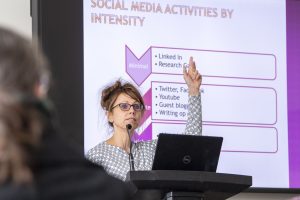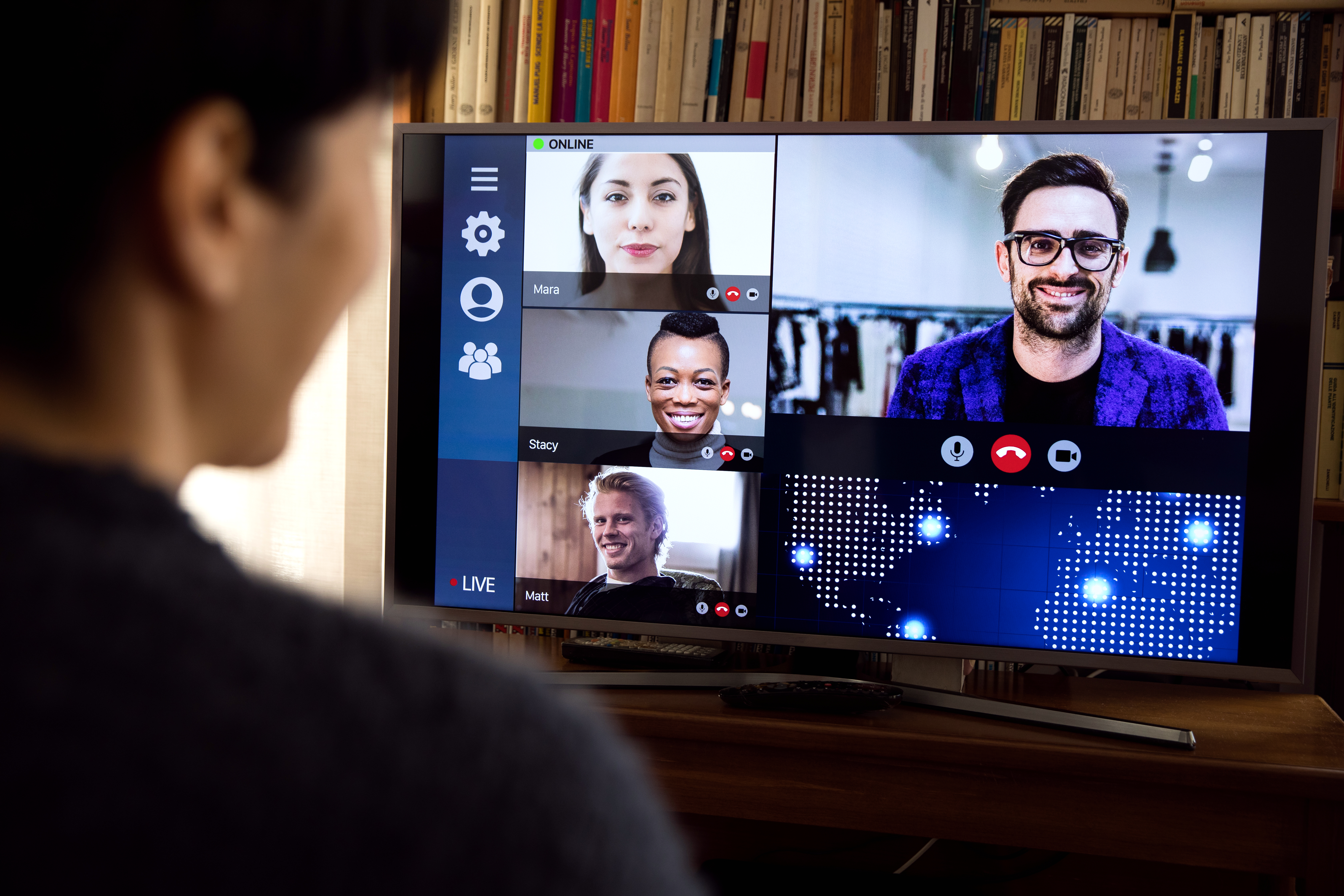You’re thinking about changing your in-person scientific or research conference to a socially distant virtual event – but where do you start? And is it even a good idea? Can a virtual conference be as successful as a live event?
Sherry Pagoto, a professor in UConn’s Department of Allied Health Sciences and director of the UConn Center for mHealth and Social Media, recently took the leap and transitioned the center’s conference from an on-campus, two-day program in Storrs to an online-only event on May 14 and 15 that was so successful she’s planning to keep the annual conference virtual for the foreseeable future.
UConn Today sat down – virtually, of course – with Pagoto to learn more about the conference and how she and her team brought the event together.
This was a really extensive, two-day program to put together. When did you start planning to turn this into a virtual event?
When the pandemic was declared in March, the writing was on the wall that no one was going to be able to travel. The decision was do we cancel, or do we go virtual? Our first order of business was, let’s look at the losses we’ll take by going virtual versus cancelling, and look at what we could gain by going virtual. And it was really a no-brainer.
So, we made the decision as quickly as possible when the pandemic was declared so that we had the most time possible to plan. I realized that the sooner we pivot the better, because we have to figure out how to get the whole thing online and what the best technologies to use are.
How did you get started with making the transition to a virtual event?
University Events and Conference Services was an amazing help to us. If anyone is thinking of going virtual, I would encourage them to get in touch with Conference Services. We consulted with them about what would happen if we went virtual. Obviously our budget was going to change, so we talked that through, and they referred us to a professional who assisted with a virtual conference at Columbia University that went really well. I connected with him, and he helped us set it all up.
We were definitely worried about how this was going to go. Like, this could be a disaster, because none of us had any experience doing this. But it was a big success, and I know that Conference Services was excited about that, too.
Your program included both live and pre-recorded media and used a big combination of technologies to communicate and engage conference participants – what tools did you use and how did you bring them all together?
The professionals that we worked with had suggested that we webcast the conference instead of having 100-plus people on a Zoom session, which can be logistically challenging and carries some risks, such as Zoom bombers. The entire program was webcast via Total Webcasting. We used Zoom for smaller breakout sessions and for the workshops, which also had smaller attendance.
I had attended a large webinar given by the World Health Organization, and they had used Slido, which is a tool that allows speakers to interact with the audience in real time. You can do real-time polls or ask the audience open-ended questions. The webcasting software that we used had a Slido plugin, and all the interaction on Slido appeared on the webcasting platform, so users didn’t have to switch over to Slido to see what was going on — it was happening right there on the screen.
One thing that we really think about every year with our conference is, how do we give our audience more exposure to the speakers? Participants want to interact with the speakers, but how do you do that online? So, we had informal breakout sessions where a small group of people could do extended Q-and-A with each speaker over Zoom.
Additionally, we always have a poster session at our conference, but we wondered how we could possibly do a poster session virtually? Instead of doing a poster, we asked presenters to shoot a one-minute YouTube video about their project. We offered awards for most viewed video and had judges select the best student and overall video. We played the poster videos over the webcast while people were grabbing lunch. Presenters got really creative; some of the videos were TikToks, some were whiteboards – they did all sorts of things, and that made it a ton of fun.
The other nice thing about one-minute videos was that presenters were sharing their videos on social media, and many of them had hundreds and hundreds of views before the conference even started. That’s certainly more mileage than you would normally get for a conference poster! We loved the idea of making the science sharable so that presenters could get their work to a larger audience and have something to put up on their own websites.

To provide further opportunities for engagement, we had a conference hashtag on Twitter, #uconndigital20, so that attendees could follow each other and continue the discussion. The hashtag had over a million impressions, and it was nice to have multiple ways that people could interact with each other and share their science through Twitter.
How was the conference attendance and response from participants?
It was our most successful conference yet! We normally attract about 100 or so attendees, mostly coming from UConn and a few surrounding universities. But this year we had 206 attendees from 50 institutions – including 13 companies – four continents, seven countries, and 25 states! We had people in Australia, Europe, and even one participant from Africa. We also had a record number of poster video submissions.
It was so successful that we plan to do it virtually again next year since we have expanded our audience nationally and internationally. It was exciting to be able to see how much we could have our conversations and scientific discourse on a much wider scale.
Another interesting thing that happened was that people were signing up for the conference during the conference because they had seen the Twitter chatter. Someone even tried to sign up at 2:00 p.m. and we said, “Are you sure because we’ve only got a couple hours left?” They said they saw a tweet and it looked really interesting, so they thought they’d jump in!
Walk-ins could happen in a regular conference, but it was interesting how the public chatter on social media brought people in, and I would actually be more proactive about stimulating that next year. We could generate more Twitter chatter the day before or the morning of to pull people in. I think 15 to 20 people joined within 24 hours of the conference starting, and which had us saying, “Whoa, where did these people come from?”
What other lessons did you learn that you plan to apply to next year’s virtual conference?
From a nuts-and-bolts perspective, because it’s online, you don’t need long breaks in the agenda. We had a lunch break, but I think it was unnecessary. Our agenda was based on the agenda we were originally going to do in person, and then as we were going through the day, I thought, we’re online, we don’t really need a full-blown lunchbreak, just more, shorter breaks throughout the day.
The other thing you really have to think about are ways to engage people, because the risk of virtual is that even if people are on, they might be multitasking – they may have walked away from their computer, they might be doing email, they might be writing a paper. There’s more risk of people not paying attention, so I think the bar is higher in terms of really keeping people engaged.
Now that I’ve done it, I would do more to make sure the speakers feel comfortable using the software tools that engage the audience. Some of our speakers used the tools a lot, and when they did, attendees really loved it. For example, there was one speaker who did several polls during her talk – she was asking the audience all kinds of questions, there was a lot of back and forth, and it made it really fun.
Next time I will really encourage speakers to use those tools and make sure they feel comfortable doing so. Most people are not used to using these tools during a conference, so their talks don’t naturally have points to engage the audience built into them, so you might have to coach them a little bit on how to go about doing that.
Also, one thing I wish we had was a function where the audience can chat amongst themselves during the conference and do more networking. I want to think through how to stimulate the audience to engage in ways that would create rich conversations. The more the audience engages with the content, the more they’re going to stay tuned in.
Is there any other advice you have for other members of the UConn community who are considering taking their conferences virtual?
My advice is to hire someone who has experience with the technology necessary for virtual events so that you don’t have to worry about that aspect. As the host, it felt good knowing that someone was in charge of the technology, and I didn’t have to think about it, I could just focus on my role as the host. We did a number of “dress-rehearsal” sessions with our tech people before the conference just to get everyone familiar with the technology and to get everyone involved comfortable with their roles.
And then we had backup plans. I had a lot of anxiety a few days before the conference – what if the speakers lose their internet connection? Or Zoom goes down during a breakout session?
We had a backup plan where, if a speaker disappeared right in the middle of their talk because they lost their connection, we made sure they had the phone number to call in and resume their talk. The moderator had speaker slides queued up and was ready to push the slides for the speaker in the event this was needed. This way, we could just seamlessly move past the problem, as opposed to trying to troubleshoot on the spot. Let’s go immediately to Plan B and minimize how much time is wasted on the technical difficulty.
And then we thought, what if Zoom goes down completely? We had links to a WebEx at the ready so that we could pivot to it for any of the aspects of the conference (e.g., breakout sessions) that relied on Zoom. So having backup plans in place, even for unlikely events, will actually make you feel less anxious.
Another piece of advice is that whatever technology you use, you want to make sure you have very clear instructions for your audience and repeated opportunities for them to have information about how it works. You don’t want to just send an email once. We sent calendar invites that had all of the instructions in them so that if people lost the email all of the instructions were in their calendar.
Also, you want to make sure that you have a staff person who’s dedicated to answering emails very quickly during the conference in case an attendee needs help.
Finally, we had one helper in every separate session handling the administrative aspects. I had my graduate students help out with this, which allowed them to interact more with the speakers and, of course, experience learning the inner workings of a virtual conference!



